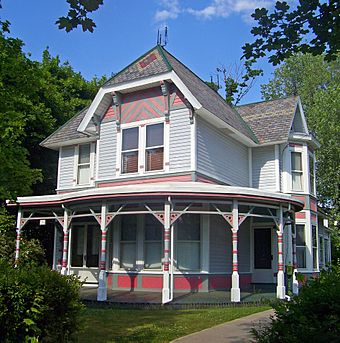William J. Dickey House facts for kids
Quick facts for kids |
|
|
William J. Dickey House
|
|

Front (west) elevation and south profile, 2008
|
|
| Location | Cohoes, NY |
|---|---|
| Built | 1890 |
| Architectural style | Stick-Eastlake |
| NRHP reference No. | 98000138 |
| Added to NRHP | 1998 |
The William J. Dickey House is a special old home in Cohoes, New York. It was built in 1890 for William J. Dickey. He was the manager of a big fabric factory nearby.
This house is a fantastic example of the Queen Anne style of homes. It shows how houses were built and decorated back then. Because of its history and unique style, it was added to the National Register of Historic Places in 1998. This means it's an important building worth protecting.
Contents
About the House's Design
The William J. Dickey House is a two-story building made of wood. It has a special roof shape called a cross-gabled roof. The front of the house has a porch that wraps around to the side.
Cool Features of the House
One part of the front of the house sticks out. It has cool decorations that are part of the "Stick-style" design. On the side of the house, there's another section that sticks out. It has tall windows that let in lots of light.
If you look at the north side of the house, you'll see a beautiful round stained glass window. This window lights up the staircase inside.
Inside the House
The inside of the house still looks much like it did when it was first built. Many of the original walls and fancy door frames are still there.
The Barn and Garage
Behind the main house, there's a small barn. It has wooden siding and a gabled roof. This barn is also considered an important part of the property. Today, it is used as the house's garage.
History of the Dickey House
Imperial Avenue, where the house is, was one of the first streets built after Cohoes became a city in 1869. This new street helped open up land for new homes. Many managers and important people from the city's factories built their houses here. The Dickey House is at the highest point on this street.
A Warm Welcome in 1890
The local newspaper, The Cohoes Daily News, wrote about the Dickeys moving in on March 1, 1890. Just a few days after they moved, their friends surprised them with a visit! They gave Mr. and Mrs. Dickey a special hanging lamp as a housewarming gift.
Changes Over Time
About ten years later, in the early 1900s, the beautiful stained glass window was added. Since then, the house hasn't changed much. It is still a private home today, where people live and enjoy its history.

